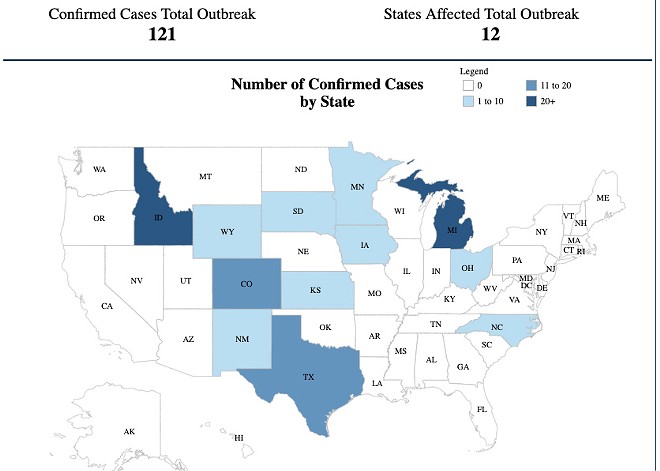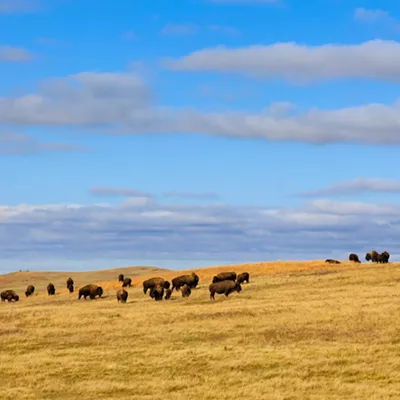
A highly pathogenic strain of bird flu (H5N1) has been slowly but steadily making its way through the country in an unprecedented way. While bird flu usually transmits between birds, transmissions have been recorded in herds of dairy cattle the past few months.
So far, 121 confirmed cases of bird flu in dairy cattle have been recorded in 12 states, with the largest outbreaks in Idaho (26 cases), Michigan (25 cases), Texas (17 cases) and Colorado (18 cases).
Since the first case in cattle was confirmed in late March, scientists and virologists have been working to figure out how it occurred. Nationally, the U.S. Department of Agriculture (USDA) is leading the research, but researchers at the Washington Animal Disease Diagnostic Laboratory in Pullman are working the case locally.
While there's been much research on zoonotic viruses — infections that spread between humans and animals — experts didn't expect this recent transmission from birds to dairy cattle, says Kevin Snekvik, executive director of the diagnostic lab, located at Washington State University.
"This is a new situation that has not been diagnosed before," Snekvik explains. "We're still trying to figure it out."
Snekvik's lab is the only of its kind in the state, he says, making it one of the best places in the Pacific Northwest to research these viruses.
Earlier this month, the lab received a $1.5 million grant from the Centers for Disease Control and Prevention to identify and track respiratory pathogens — such as this recent strain of bird flu — that could spread from livestock to humans. It's not common for bird flu to spread to humans, but this viral strain has already infected three people who were in contact with infected cows.
Snekvik's lab had been working to explain the recent transmission for months before receiving the grant. In April when the first case was detected in Idaho, the lab's staff rushed to the scene to confirm the case and sequence the virus' genome. Put simply, they're uncovering exactly what's in the virus' DNA.
By comparing the DNA they recovered to already-available samples from the USDA, the Washington virologists were able to reveal that cattle recently transported from Texas had brought the virus with them. However, they haven't been able to decipher exactly how the original viral transmission happened.
They've also partnered with University of Washington Medicine to study the virus' transmission, with WSU's lab dealing with any cases that have been found in animals and UW Medicine working to understand how it'll affect humans. The two organizations are still figuring out how they want to work together.
"We're still working with UW Medicine to figure out what that partnership really looks like," Snekvik says.
KNOWN AND UNKNOWN
Virologists have struggled to understand how this virus is transmitted because it's been affecting different species differently, Snekvik says.Typically, bird flu is a respiratory infection that spreads rapidly between wild birds and is often highly pathogenic, killing infected birds quickly.
However, in other species like cats and raccoons the virus usually attacks the brain.
Snekvik says the running theory is that in some cases, animals are feeding on the carcasses of an infected bird and the virus travels through the animal's nose up to its brain. More often than not, he says, a bird flu infection in those cats and raccoons is deadly.
But in dairy cows, the virus is taking root in their mammary glands, ultimately affecting their milk production. The vast majority of cows recover from the infection and can go right back to producing at their full capacity.
"The positive on what we see over time is that [dairy cows] are developing antibodies, and they don't appear to be able to be reinfected," Snekvik says. "Their natural immune system seems to be working effectively against this virus."
Snekvik is confident in his lab's ability to understand what's going on with this new transmission, because of how much they know about influenza viruses.
"The fact that this happens with influenza is a good thing because we understand influenza better than other viruses," he explains. "With COVID, very little was known about its transmission, making it a lot scarier to the public."
However, since the infection is taking place in cows' mammary glands, the virus is making its way into the milk they produce. While that can be scary, he says that the act of pasteurizing the milk completely deactivates the virus.
"Studies have shown that pasteurization has protected humans for almost 100 years now," he says.
DAIRY DILEMMA
Idaho has one of the largest dairy industries in the country, generating close to $11 billion in sales among its more than 600,000 dairy-producing cows, so it's no surprise that the state has also recorded the most bird flu cases in its herds.Rick Naerebout, who runs the Idaho Dairymen's Association, says dairy farmers are doing everything they can to prevent further transmission of bird flu in the state's herds, but they're restricted by a lack of knowledge on this new viral strain.
"Our dairymen are taking as many preventative measures as possible," he explains. "It seems more luck of the draw because everything has been so variable."
After Idaho recorded its first case of bird flu in dairy cattle on April 2, infections in cattle initially spread slowly, with about two weeks between each new infection. By mid-May, new infections were being recorded every few days, USDA data show. Then on May 30, Idaho saw eight cases of bird flu recorded in one day.
Most of the confirmed cases have been in Magic Valley, which Naerebout says isn't surprising as the region houses about 75% of the state's dairy farms.
Naerebout has worked in Idaho's dairy industry for more than two decades, and he says that these outbreaks aren't anything to panic about yet. Snekvik agrees, stating that the new infections are really just a symptom of the world we live in.
"The world is more complicated and interconnected than it's ever been before," Snekvik says. "That's why we're seeing this affect other species than just birds."
While this virus is usually deadly to the birds who carry it, it's only really been causing minor symptoms in dairy cows, including a drop in appetite, fever, and an off-color, off-texture milk. But the reduction in milk production can be costly for dairy farmers.
"Most productive herds are taking a big hit on their revenue when they record an infection," Naerebout says. "Some dairymen are seeing as much as a 20% reduction in milk production in the worst-case scenario. Other dairymen are only seeing a small 5% drop in production."
After the May 30 surge in cases, transmission slowed back to an infection every few days, leading Naerebout to think the state's starting to recover.
"I've been talking to dairy producers, and it's feeling like we may be through the worst of it," he tells the Inlander during a June 17 interview. Since then, there have been four more confirmed cases in Idaho.
In total, Idaho has recorded 26 confirmed cases since April 2, with 17 confirmed cases in the last 30 days, according to USDA data. The only state that actually comes close to the recent transmission is Colorado, which has recorded 14 confirmed cases of bird flu in the last month.
Both Snekvik and Naerebout recommend that farmers who think their cattle may be infected reach out to their state veterinarian. In Washington, that's Amber Itle with the state's Department of Agriculture. In Idaho, that's Scott Leibsle with that state's Department of Agriculture.
HUMAN HAZARD?
Meanwhile, there have only been three instances where farm workers have contracted the recent strain of bird flu, all of which occurred on the job while working with a sick cow. And while it's not entirely known how they were infected, the presumed route of infection has been through their eyes, the New York Times has reported.In two of the three farmworkers, the primary symptom of their infection was pink eye (or conjunctivitis), which is atypical of a bird flu infection. So far, none of the three infections have spread to other humans.
However, according to Yoshihiro Kawaoka, a virologist and bird flu expert at the University of Wisconsin-Madison, there is no guarantee that the virus won't mutate and become easily transmissible between humans, the New York Times reported.
Viral mutation isn't uncommon to researchers as similar instances have occurred many times before. In 2009, a swine flu (H1N1) outbreak saw nearly 500,000 human infections around the globe and more than 18,000 people died from it, according to the World Health Organization.
Even though this recent avian flu outbreak hasn't effectively spread between humans, Anice Lowen, a virologist at Emory University, says the real danger may come if a farmworker is infected with both bird flu and a seasonal flu virus at the same time, the New York Times reported. This could cause the two flu viruses to swap genes, effectively adding the efficient spread of a seasonal flu virus to the bird flu virus, creating an outbreak that could more easily spread between humans.
"Anything we can do to limit seasonal infection in people that are occupationally exposed to H5N1 could really reduce risk," Lowen told the Times. ♦


























